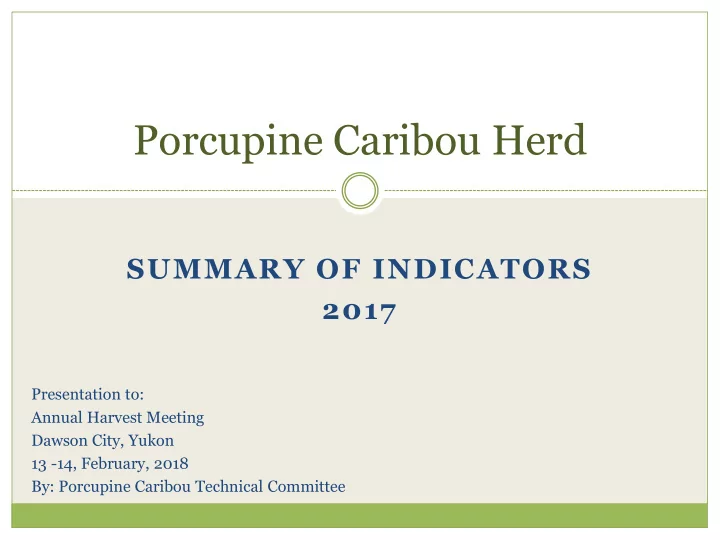

Porcupine Caribou Herd SUMMARY OF INDICATORS 2017 Presentation to: Annual Harvest Meeting Dawson City, Yukon 13 -14, February, 2018 By: Porcupine Caribou Technical Committee
Range of Porcupine Caribou Herd
Range of Porcupine Caribou Herd
Range of Porcupine Caribou Herd
Range of Porcupine Caribou Herd
Range of Porcupine Caribou Herd
Range of Porcupine Caribou Herd
Range of Porcupine Caribou Herd
Calving
Population Harvest Body Condition Habitat Alaska Department of Fish and Game Overview
Population Size Methods Results Count caribou using a photocensus July 1 st , 2017 Alaska July 4 th , 2017 Yukon Photo-direct technique and digital photography
Population Size
Population Size Methods Results 250000 218,457 caribou 218,000 caribou 225000 in 2017 (202,106 - 234,808) 200000 Population Size 175000 Minimum count = 150000 197,894 caribou 125000 Increasing ( λ =1.35) 100000 75000 similar to growth rate 50000 between 1972-1989. 25000 0 1970 1975 1980 1985 1990 1995 2000 2005 2010 2015 Upper CI Lower CI
Calf Birth Rate and Survival Methods Results Classify pregnancy on calving grounds 88% of females pregnant 100% evidence of pregnancy Check to see how many calves survive after 1 month 90% calves survived After 1 month: 72 calves per 100 cows
Adult Female Survival Methods Results Annual Survival of Adult Female Porcupine Percentage of females Caribou (Error bars are 95% confidence limits) that survive each year 1.0000 0.9000 0.8000 Last completed 2012 0.7000 Survival Rate Priority for the PCTC to 0.6000 0.5000 assess using satellite GPS 0.4000 collars (ADF&G lead) 0.3000 0.2000 Results to date indicate 0.1000 survival in the 85%+ 0.0000 2003-04 2004-05 2005-06 2006-07 2007-08 2008-09 2009-10 2010-11 2011-12 range Caribou Year (calving to calving period)
Adult Sex Ratio Methods Results Determine the ratio of bulls to cows in the fall Attempted October 2017 Unsuccessful due to poor weather Herd in Alaska 2010 = 57:100 (Bull:Cow) Alaska Department of Fish and Game
Composition Count Methods Results Determine the ratio of calves to cows in March March 2017 Classify 200 caribou around each collar Herd in Alaska 2017 = 35.8 calves: 100 cows Alaska Department of Fish and Game
Population Roll Up Herd increasing, highest recorded point Pregnancy rate higher than average Calf survival higher than average March calf-cow ratio average Alaska Department of Fish and Game
Population Harvest Body Condition Habitat Alaska Department of Fish and Game Overview
Harvest Monitoring Methods Interview based sampling survey of user groups 1. Harvest estimates, sex ratio of harvest Rob Florkiewicz (YTG) present harvest results
Population Harvest Body Condition Habitat Alaska Department of Fish and Game Overview
Caribou Body Condition Methods Results How healthy individual Generally – very good caribou are by shape for time of year measuring back fat and Cows - body condition rating animals above average, backfat Fall and winter 2016-2017 below average hunter samples submitted Bulls – body condition (Old Crow and NWT) and backfat below 78 cows and 31 bulls average sampled for backfat
Caribou Body Condition Average condition of harvested caribou 1=poor, 2=fair 3=good 4=very good
Caribou Body Condition Average Depth of Backfat (cm)
Population Harvest Body Condition Habitat Alaska Department of Fish and Game Overview
Wildland Fires Methods Results Amount of PCH range burned as an index of range condition 1960 — 2017 Fires in red are new as of 2017
In 2016 there were 9 fires in Alaska, and no fires within the YT and NWT portion of the PCH range. In 2017, 53 fires burned in AK and YT. Wildland fires in PCH Range
A fraction of the area burned in the previous 5 years. Total area burned is roughly 17% of herd’s total annual range since 1960. 2017 saw an additional 2% of the range burn that had not been burned since 1960. Wildland fires in PCH Range
Human Disturbance and Footprint Methods Measured total linear footprint for each disturbance type No appreciable change in linear footprint in 2016/2017
Snow Conditions Methods Index of winter conditions Measurements of depth and snow density measured at 17 permanent locations 1977-2016 Alaska Department of Fish and Game
No trends or large changes from long term averages Peel River drainage = slightly below average snow depth, average density Eagle River drainage = above average snow depth, average density Snow Conditions
Winter distribution northwest of Old Crow and northeastern Alaska Almost no snow in early winter in Old Crow Range Further west average snow conditions No ice layers Snow Conditions encountered
Habitat Roll Up Habitat did not change much over the year with the exception of fires in the winter range Snow conditions average where caribou spent most of the early and late winter Alaska Department of Fish and Game
Questions? Peter Mather
Indicator Table - Nov. 2016
Indicator Table - Nov. 2016
Indicator Table - Nov. 2016
Recommend
More recommend